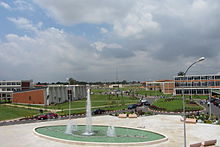Prof Robert A. Samson is at the moment the Secretary General of the International Union of Microbiological Societies. As well as, he can be an Executive Editor of an international scientific journal, particularly Studies in Mycology, and a member of various scientific organizations, together with the British Mycological Society, the American Mycological Society, the World Federation of Culture Collections, and the International Union for Microbiological Societies. Dr. Ashlock credit this experience for lending her a better understanding of the beneficiaries of medical analysis-people all around the world. Therefore, current fungal taxonomic research usually uses a polyphasic approach combining phenotypic, genotypic and chemical characters to supply better identification results. He additionally urged all food mycologists to comply with the current taxonomic schemes because appropriate species identification remains to be essential in tackling the issues of contamination of meals and the potential manufacturing of mycotoxins. SEAMEO BIOTROP featured Prof Robert A. Samson from Westerdijk Fungal Biodiversity Institute, Utrecht, the Netherlands, in its third Quarterly Public Seminar 2018 to current a lecture on ‘The Current Status of Taxonomy and Biodiversity of Toxigenic Fungi’. This seminar was held on 30 August 2018 at the Centre’s headquarter in Bogor, attended by 75 participants from various analysis and government establishments, universities and companies.

 As a conclusion, Prof Robert conveyed the increase of the meals-borne mycobiota biodiversity due to new taxonomic insights which give a extra refined species delimitation. Fortunately, he stated, the fungal identification course of is at the moment facilitated by a wealth of available knowledge on the growth, distribution and doable production of toxic metabolites of the recognized meals-borne species, thus, limiting any attainable harm that will happen. He has been working on the Westerdijk Fungal Biodiversity Institute in Utrecht, the Netherlands, since 1970. In 1983 he became the head of the Department of Services and Applied Research in the same establishment and he formally retired on 01 April 2011. His experience in meals-borne fungi similar to Penicillium and Aspergillus leads him to be still active as Emeritus Senior Researcher of Applied and Industrial Mycology research group. On this molecular period, the molecular instruments are thought of as the primary DNA barcode for fungi. Even though many species are beneficial for other living organisms, particularly human, he stated that the variety of toxic fungi can be abundant. Fungal contamination on foods by these fungi through spoilage or presence of mycotoxins is still thought-about as a major downside inflicting extensive loss.
As a conclusion, Prof Robert conveyed the increase of the meals-borne mycobiota biodiversity due to new taxonomic insights which give a extra refined species delimitation. Fortunately, he stated, the fungal identification course of is at the moment facilitated by a wealth of available knowledge on the growth, distribution and doable production of toxic metabolites of the recognized meals-borne species, thus, limiting any attainable harm that will happen. He has been working on the Westerdijk Fungal Biodiversity Institute in Utrecht, the Netherlands, since 1970. In 1983 he became the head of the Department of Services and Applied Research in the same establishment and he formally retired on 01 April 2011. His experience in meals-borne fungi similar to Penicillium and Aspergillus leads him to be still active as Emeritus Senior Researcher of Applied and Industrial Mycology research group. On this molecular period, the molecular instruments are thought of as the primary DNA barcode for fungi. Even though many species are beneficial for other living organisms, particularly human, he stated that the variety of toxic fungi can be abundant. Fungal contamination on foods by these fungi through spoilage or presence of mycotoxins is still thought-about as a major downside inflicting extensive loss.
 Several genera of phylum Ascomycota, particularly Aspergillus, Penicillium, Fusarium and Talaromyces, are well-recognized to produce important mycotoxins equivalent to aflatoxins, trichothecenes, ochratoxins, patulin and sterigmatocystin which affect the foods negatively. Seeds are like computer systems-nobody desires to purchase last year’s laptop computer. Particularly within the last ten years, the taxonomic and phylogenetic research have increased and demonstrated that many nicely-recognized species are in fact representing cryptic taxa. Identification which only uses this sort of instruments can be not simple and infrequently doesn’t give a very good species recognition since other loci for each genus have to be applied to reach the precise identification. Prof Robert started his presentation with a observe concerning the importance of proper fungal recognition and identification. Throughout his outstanding profession in mycological research, Prof Robert A. Samson has acquired many honours, together with recipient of the USFCC/J. In the course of the graduation of her Purdue training, she sought as a substitute a career in foods and nutrition. 1982–B.S., Biochemistry and Animal Science, Purdue University, 1986–D.V.M., Purdue University, 1992–Master of Public Health, Harvard University, Cambridge, Massachusetts, 2001–Ph.D., Duke University, Durham, North Carolina, 2005-2006–Deputy Commander, U.S.
Several genera of phylum Ascomycota, particularly Aspergillus, Penicillium, Fusarium and Talaromyces, are well-recognized to produce important mycotoxins equivalent to aflatoxins, trichothecenes, ochratoxins, patulin and sterigmatocystin which affect the foods negatively. Seeds are like computer systems-nobody desires to purchase last year’s laptop computer. Particularly within the last ten years, the taxonomic and phylogenetic research have increased and demonstrated that many nicely-recognized species are in fact representing cryptic taxa. Identification which only uses this sort of instruments can be not simple and infrequently doesn’t give a very good species recognition since other loci for each genus have to be applied to reach the precise identification. Prof Robert started his presentation with a observe concerning the importance of proper fungal recognition and identification. Throughout his outstanding profession in mycological research, Prof Robert A. Samson has acquired many honours, together with recipient of the USFCC/J. In the course of the graduation of her Purdue training, she sought as a substitute a career in foods and nutrition. 1982–B.S., Biochemistry and Animal Science, Purdue University, 1986–D.V.M., Purdue University, 1992–Master of Public Health, Harvard University, Cambridge, Massachusetts, 2001–Ph.D., Duke University, Durham, North Carolina, 2005-2006–Deputy Commander, U.S.